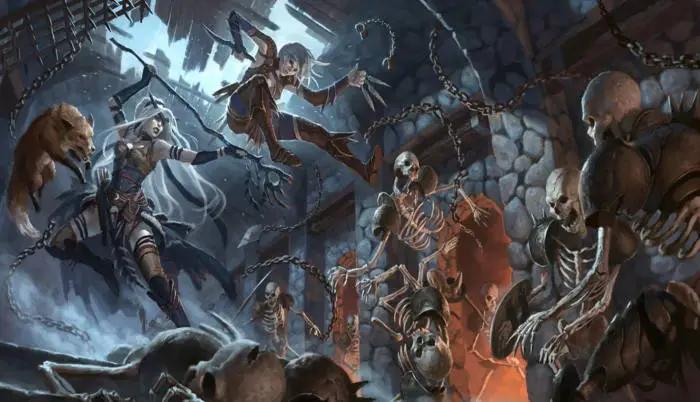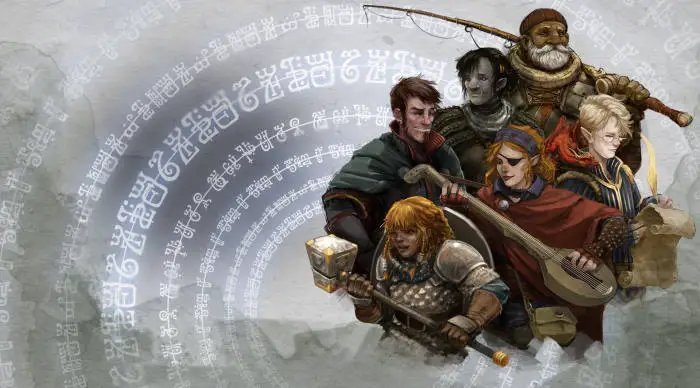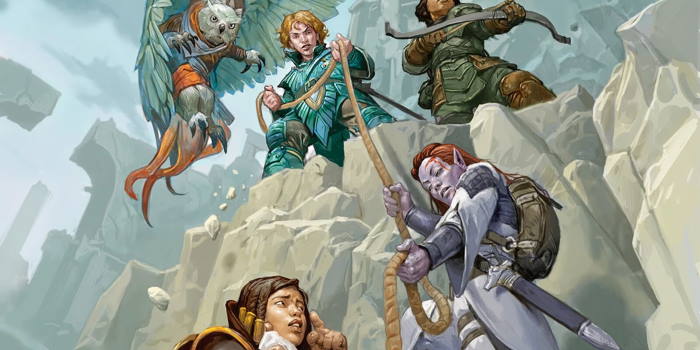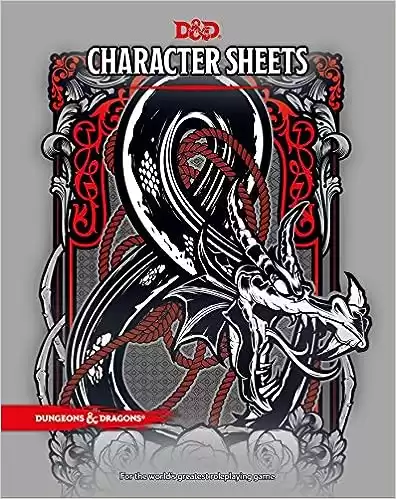In Dungeons and Dragons, a big part of the fun is developing your own fantasy hero. You could be a noble knight in the service of the local nobility, or a wicked mage in search of forbidden spells. To help define your DnD character’s motives and morals, you can give them one of nine alignments.
Alignments describe your character’s beliefs on two different axis. Lawful and chaotic refer to your character’s views on order, rules, and civilization. Good and evil, on the other hand, describe how they relate to other people and the world around them. Is your character someone who protects the weak and helps those in need, or will they achieve their goals by any means necessary? Your alignment doesn’t explicitly come up in gameplay too often, but it can help you make decisions about who your character is and what they’re willing to do.
If you want to learn more about these alignments, you’re in luck! Not only will we define every possible alignment, but we’ll also talk about how they affect gameplay and how to build a party with alignment in mind.
What Are The Alignments?
Before we go any further, it’s important that you know what each alignment is.
I’ve already mentioned that alignment is composed of two parts: Lawful vs Chaotic and Good vs Evil. To determine your character’s alignment, you simply choose one option for each axis and smash them together! If your character doesn’t have a hard stance either way, you can choose neutral to represent the middle-ground.
Here are all nine:
| Lawful Good | Neutral Good | Chaotic Good |
| Lawful Neutral | True Neutral | Chaotic Neutral |
| Lawful Evil | Neutral Evil | Chaotic Evil |
Lawful vs Chaotic
In just about every DnD game, you’ll come across towns, governments, and factions. Your character’s attitude towards rules and authority will play a huge part in how you deal with the world around you.
Lawful characters believe that order is necessary, and they will do their best to follow the rules. Oftentimes, they strictly follow the law and can be rather rigid in their beliefs. However, this isn’t always the case.
A religious character could be lawful if they adhere to the tenets of their faith. A warlock who has sold their soul to devils will follow orders from their fiendish overlord. Just because your character is lawful doesn’t mean they follow every law and order given to them. Still, they’re the most likely characters to accept authority, and they don’t break the rules without good reason.
Chaotic characters value freedom and personal choice. They’ll follow their own morals over what others tell them to do, and they may even be against the idea of laws to begin with.
Of course, not every chaotic character is an anarchist. Most just find rules and customs to be too restricting. In fact, they might not even consider the law before acting. They also won’t respect someone just because they’re in a position of power, but they could still be persuaded to follow them. Ultimately, a chaotic character follows their heart’s desire and their own conscience above everything else.
Neutral characters are usually fine with following the status quo, but they’ll break the rules if the situation calls for it.
They understand the benefits of an orderly society. However, they’ll readily accept shortcomings in governments or authority figures, and they’re willing to break the law when necessary. They might make choices based on good vs evil rather than worrying about politics.
Good vs Evil
If lawful and chaotic describe how you deal with order, good and evil describe how you relate to other people. Whether you want to be the hero or villain of your story will play a huge role in how your campaign plays out.

Good characters are the classic heroes of DnD: selfless, merciful, and kind. They want to help those in need and do the right thing whenever they can.
Of course, good characters can (and should) have flaws. Nobody is perfect, and exploring the limits of your character’s good-hearted nature can be exciting. Good also doesn’t mean naive. Most good characters can tell when someone is trying to take advantage of their kindness. Just remember that good characters don’t want to hurt innocent people, and they’ll do what they think is best for everyone around them.
Evil characters are willing to harm or even kill just about anyone to achieve their goals. In fact, hurting people may be necessary for them to succeed. They act in their own self-interest without worrying about how they might affect innocent people.
Still, not all evil characters will kill whomever they want, whenever they want. They should still have desires or goals that motivate their actions. They might also have a few people they care about and want to protect. For example, a deadly assassin who loves and protects their family could still be evil. Regardless, an evil act will cause pain, distress, or even death, and evil characters are willing to perform them regularly.
Neutral characters might not go out of their way to help people, but they also won’t typically try to hurt them. Other principles, such as whether they’re lawful or chaotic, will often guide their actions.
Detailed Breakdown
Now that you know what each axis of alignment means, let’s take a look at how they work together. Listed below are the descriptions for all nine alignments, as well as examples from pop culture.
Remember: there’s no single interpretation of these alignments. You can tweak these definitions for your own characters and settings. In fact, giving your character some contradictions can lead to fun, unexpected moments at the table.
RELATED: Commander Legends: Battle for Baldur’s Gate – All Available Products
Lawful Good
Lawful good characters believe that governments and laws are necessary for a good society. These characters are also the most likely to have a strict personal code and distrust those who don’t live up to their standards. Until they have an excellent reason not to, they’ll trust authority figures and follow all the rules.
Examples: Superman, Mr. Spock
Neutral Good
Neutral good characters don’t have any strong feelings about society or power structures; they just want to help others and do the right thing. They’re willing to listen to authority and play by the rules, but not when it would cause harm to innocent people. Ultimately, morality is the main factor behind their actions.
Examples: Luke Skywalker, Gandalf
Chaotic Good
Chaotic good characters are compassionate and helpful, but they inherently distrust order. They see corrupt officials and unjust laws and believe that people are better off acting on their own. They’ll follow their conscience wherever it takes them, even if that means working outside of laws and traditions.
Examples: Captain Jack Sparrow, Robin Hood
Lawful Neutral
Lawful neutral characters will follow a personal code without worrying about its morality. They don’t care whether the result of their actions is good or evil; they care about following their orders or performing their duties. These characters may be unwavering in their beliefs, and they prefer any kind of order over chaos.
Examples: Boba Fett, James Bond
True Neutral
Out of all the alignments, true neutral is the rarest. These characters don’t care about morality, and they have no strong feelings about the structure of society. To make these characters compelling, you’ll likely need to give them some other goal or motivation.
Maybe they’re a treasure hunter always looking for a new discovery, or maybe they have strong bonds to certain NPCs. If your game has even a decent amount of role-playing, they need to care about something.
Examples: Shrek, Lara Croft
Chaotic Neutral
Chaotic neutral characters value freedom and choice above all else. They’ll act on their whims and follow their instincts, no matter what happens. These characters likely won’t follow orders and hate feeling restricted, and they have no problem acting in ways that society doesn’t expect or accept.
Examples: Deadpool, Dr. House
Lawful Evil
Lawful evil characters are precise and ruthless in achieving their goals. They are the masterminds and schemers of DnD, adhering to strict codes and hierarchies to get what they want. Lawful evil characters may desire important positions, since they see they see law and order as essential to their success.
Examples: Darth Vader, Magneto
Neutral Evil
If your character is neutral evil, they’re likely selfish, cruel, and willing to hurt anyone who stands in their way. These characters aren’t committed to following any system of laws, traditions, or morals, but they’ll use them if they serve their needs. They’ll do whatever they think is best for them, whether that means careful planning or lashing out with violence.
Examples: Sarumon, Ganondorf
Chaotic Evil
Chaotic evil characters are impulsive and violent. They’ll do what they want, when they want with no regard for the consequences. These are the most difficult characters to have in a party because reigning them in can be impossible. They have no regard for anyone else’s well-being, and they won’t listen to logic and reason.
Examples: The Joker, Orochimaru
How Do I Pick Alignments?
By now, you should have a good understanding of what makes each alignment unique. Now it’s time to put your knowledge into practice by picking your next character’s alignment. But how do you decide what kind of character you want to play?

The simplest option is to choose whatever excites you the most. Do you want to play a grizzled soldier who follows their orders, no matter the cost? Or maybe you want to play as a freedom fighter, saving people from a tyrannical government. You can have a blast playing any of these alignments at the right table, so focus on what sounds fun.
If you already have a character concept, you can probably figure out an alignment or two that would make sense. Even if you only have vague ideas, you can use these definitions to hone in on your character’s morals. Do they go out of their way to help people? Do they have a personal code or a strict set of beliefs? Would they kill someone if it were the easiest path to success?
You might also want to think about how your character fits into the party. It can be fun to play with different alignments, just make sure that in-game debates don’t lead to real-life drama. If you’re the one evil character in a good party, you probably shouldn’t go on murder-sprees if it upsets everyone else. Remember: the whole party has agreed to work together, so make a character that can coexist with the group.
If you’re still having trouble picking an alignment, there are lots of online quizzes that can help. Even if you disagree with the results, that reaction will tell you what alignment you really want to play. Here’s an excellent alignment quiz with some great, introspective questions.
How Do Alignments Affect The Game?
Alignments don’t often change the mechanics of the game. There are some magic items and effects that depend on alignment, but it’s a much smaller part of 5e than previous editions. Still, your character’s morals and beliefs will play a huge part in your game’s story.
Alignment can help set the tone for an entire campaign. If most of your party leans towards one belief, it will likely inform your quests and goals. A lawful party might work in service of a monarch or military. A chaotic party might try to dismantle those same power structures.
It’s a good idea for a party to focus on one trait if there’s no other common goal uniting them. Not every character needs to be the same alignment, but agreeing that the party trends towards good, for example, is useful. Of course, this certainly isn’t necessary, especially for groups that have played together for a long time. But with newer players or strangers, it can be nice to have a unifying principle.
Alignment also helps you make in-game decisions. If you don’t know how your character reacts to a plot twist, or deals with a certain dilemma, you can look to their alignment. This system can’t tell you exactly what your character thinks or feels, but it can help guide you when you’re feeling unsure or conflicted.
Can My Character Change Alignments?
Yes! Just like in real life, your characters will change and grow over time, so it makes sense to shift their alignment. You might never change your character’s alignment, or their journey might have them going from one end of a spectrum to the other.

Keep in mind: shifting a character’s worldview is no small task. They won’t just change if someone convinces them, or if they see that they were wrong once or twice. A character’s alignment should come from a defining experience. Maybe they resolved an inner conflict they’ve been struggling with all their life, or they saved someone they love by using new methods. Whatever happened, it should be an important moment in their story.
Of course, you might also find that you play your character differently than their alignment would suggest. Maybe you thought your character was chaotic good, but you have the most fun when you play them as chaotic neutral. It’s perfectly fine to change your character’s alignment to reflect how you view them. You should do what feels right rather than force yourself to stick with one alignment.
Do I Need to Pick Alignments for NPCs?
Knowing the alignment of your important NPCs can be very useful. Even if you’re just jotting down some quick notes, taking a moment to pick an NPC’s alignment can help you when you have to role-play them. If you have time, write down what makes that NPC a certain alignment. What code does a lawful NPC follow? How does a good character help their community? What has an evil villain done to deserve their alignment?
When preparing animals, plants, or other creatures, keep in mind that they might be unaligned. A creature incapable of moral reasoning or complex thought can’t have an alignment. After all, these creatures act on instinct and survival needs rather than a system of ethics. Otherworldly monsters may be an exception to this rule, since they may have been created to act as a certain alignment.
How to Settle Disagreements About Alignments
During a game, you might find that another player disagrees with your decisions based on alignment. Maybe they think that your character wouldn’t do something “because they’re lawful good.” Or maybe you’re the DM, and two of your players disagree about what their alignments mean.

First, remember that there’s no one way to interpret an alignment. There are an infinite number of ways to play the exact same alignment, each subtly different from the others. That’s simply the byproduct of only having nine options to express every moral and political position. Alignments are a guide, not a rule (sorry lawful players).
Players shouldn’t accuse each other of taking actions “their character wouldn’t do.” Only one person knows how a character will act in a given situation, and that’s the player controlling them. Contradictions, exceptions, and nuances help make DnD characters compelling. They should be explored, not shamed.
If a player consistently bugs you about alignment, respectfully tell them that you know your character, and you’re the one in control of their actions. If the problem persists, ask the DM, or the whole table, to help resolve things.
End of Session
We’ve covered all the definitions of alignment, as well as how they can make your campaign more cohesive and compelling. Just remember: alignment is a tool to help you develop your character. It doesn’t have the strict mechanical weight it used to, so don’t stress too much about it. You can focus on your alignment as much or as little as you want.
I hope this article taught you everything you wanted to know about DnD alignments, or at least given you some inspiration for a new character concept!





